10 Surprising Ways to Get Exposed to Formaldehyde
A mother wrote to ACN Latitudes, “I was shocked to find that my son’s tics increased dramatically when he was exposed to new cabinets in our kitchen. I later learned that the culprit was formaldehyde.”
Formaldehyde, a common and toxic chemical, has found its way into a broad range of consumer items. Some people are highly sensitive to it and react to very low levels of exposure. It is also a suspected carcinogen. Check out this list of products that typically contain or release formaldehyde:
- New clothes
- Bedroom linens
- Drapes
- Upholstery
- Personal care products
- Pressed wood products
- Urea-formaldehyde insulation
- Environmental tobacco smoke
- Disinfectants
- Germicides and fungicides
Families need to be vigilant to avoid this chemical. One of the most common exposures is from clothing. Use of formaldehyde in clothing is not regulated in the United States and is often used to prevent wrinkles in fabric and to prevent mildew during transportation. To avoid it in clothing and linens, don’t buy wrinkle-free products and look for organic, untreated cotton.
To wash new clothes that have been treated:
It can be helpful to wash laundry with your detergent along with 1 cup baking soda and 1 cup vinegar; rinse twice. Multiple washings may be required to remove formaldehyde from treated clothes. Use water that is as hot as the fabric will tolerate.
Details from the Environmental Protection Agency on formaldehyde: click here.









